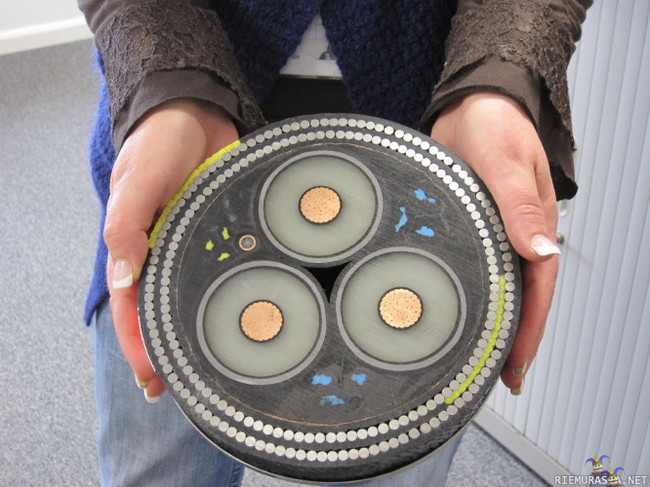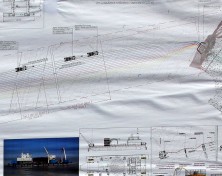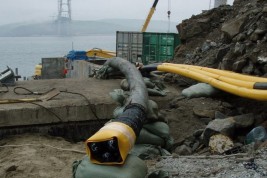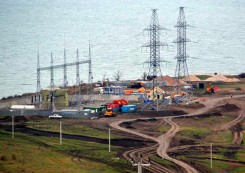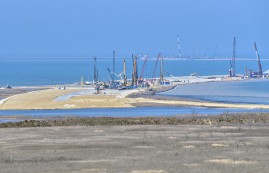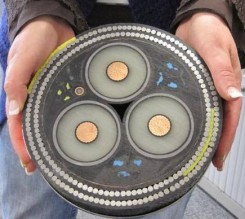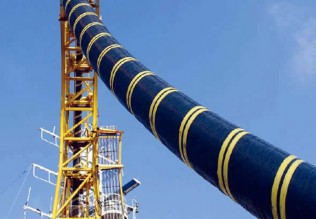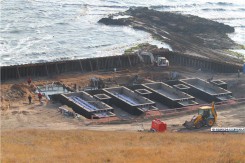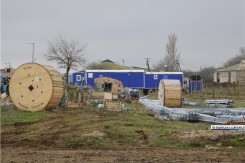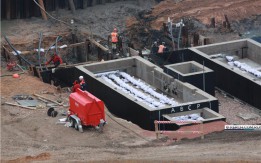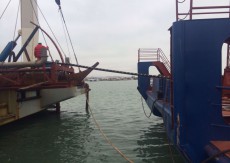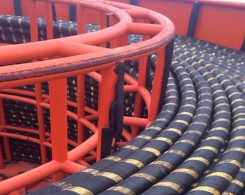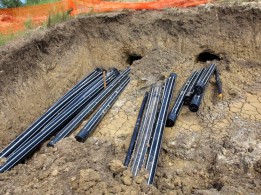April 5, 2016 at 08:34, 2465
"We need to build a famous bridge that would connect the Crimea with the Caucasus, with the territory of the Russian Federation. This can and should be done as soon as possible. "
V. V. Putin
The energy bridge in Crimea is an unofficial name for a group of energy facilities for the energy supply of the Republic of Crimea from the mainland of Russia.
The energy bridge is being built simultaneously in six locations: a power line is being drawn from Rostov NPP to the Taman Peninsula, where a substation is being reconstructed, and air lines are laid before the cable passage along the Kerch Strait and from the same cable passage to Kerch and Feodosia.
- The main supplier of cable for the energy bridge in Crimea was the Chinese company Jiangsu Hengtong HV Power System
- The total length of the cable transition is 13 480 m
- A total of 220 800 m of cable will be laid on the sea section, 16 480 m on the land
The project includes a power line Rostov NPP - Simferopol. One of the plots is laid along the bottom of the Kerch Strait. It was planned that since December 2015 the capacity will be 300 MW, with the maximum permissible flow of 403 MW. By June 2016, the nominal capacity is planned to be increased to 850 MW.
The power line will consist of the following main elements:
500 kV transmission line from the Rostov Rostov-Andreevskaya-Vyshesteblievskaya nuclear power plant with a length of 500 km, a 500 kV Kuban-Vyshesteblievskaya power line with a capacity of 1,165 MVA with a length of 125.7 km, two double-circuit cable lines 220 kV Taman-Kafa and Taman - Kamysh-Burunskaya. "
LEP 220 kV "Kafa-Simferopolskaya": it is planned to build a new transmission line with a length of 116.2 km, working voltage - 220 kV, construction will be conducted in 330 kV dimensions, plan - 2017, on the existing power line from Feodosia to Simferopol, reconstruction of 7 km in dimensions of 330 kV. At the first stage, the distribution substation RP of 220 kV "Taman" with taps from the VL 220 kV "Vyshesteblievskaya - Slavyanskaya" will become the point of connection to the UES of the South.
In 2016, the following substations are planned:
Substation "Taman" (3xAT 500/220 kV at 501 MVA), Substation Kubanskaya. In the Crimea, the connection points will be substations: Substation Kamysh-Burun near Kerch, Substation Kafa 220 kV with capacity 250 MVA near Feodosia, further expansion is planned to 330 kV, PS Feodosiyskaya 220 kV, Substation Simferopolskaya 330 kV, Simferopol TPP.
October 11, 2015, the ship-laying cable JIAN JI 3001 arrived in Kerch, after laying the cable in a drum on October 17 the ship went to the work site.
By November 27, 2015 in the Crimea was built 250-kilometer power line from Kerch to Feodosia and other facilities for taking power from the first stage of the energy bridge.
December 2, 2015, Russian President Vladimir Putin, together with the leadership of the Crimea and employees of the Crimeanenergo, launched the first stage of the energy bridge in the Crimea, which supplies electricity to the peninsula from the Kuban. The breakthrough of the energy blockade of the Crimea began.
December 15, 2015 the second branch of the energy bridge in the Crimea earned. Flow 500 mW. By the end of 2015, Crimea gained independence from the supply of electricity from Ukraine, and its power system became part of the unified energy system of Russia. The first launch complex was implemented in December 2015, and the maximum allowable flow from the Unified Energy System of the Russian Federation will be 403 MW.
Recall that for the whole project there are four branches, which in the future should fully provide the Crimean peninsula with electricity. When by the middle of 2016 (presumably, by the summer) the second phase of the energy bridge will be put into operation, then the flow of electricity will amount to 800 MW. Completely the construction of the Kerch bridge is planned to be completed by 2019 in the framework of the development program of the Republic of Crimea.
What cable is used for the energy bridge in the Crimea
This is how the cable looks in the section, according to which the Crimea receives electricity from the mainland
The energy bridge, laid along the bottom of the Kerch Strait, consists of four cable lines.
Cable laying under water is provided in separate trenches with a depth of up to 2.5 m relative to the bottom mark with a distance of 10 m between the cables. The total length of the sea cable will be 220,800 meters.
Cable passage through the Kerch Strait
For each of the 4 lines, four cables will be laid: three workers one for each phase and one for the backup. Laying and burying will be carried out with the help of a barge-cable laying, a towed harbor chute with a hydraulic plowing device "Plow", a boat-spotter and a pusher boat. The transition is being built in the northern part of the Kerch Strait.
Under the water, the main section will be laid in separate trenches with a depth of up to 2.5 m and a distance of 10 m between the cables. On the way to the shore, the cables will be laid in a common trench.
The total length of the cable transition will be 13 480 m. In total, 220 800 m of cable will be laid on the sea section, and 16 480 m on the overland section. The cross-section of the sea cable is 1000 mm², the cable on the land section is 1200 mm².
The use of the cable in land areas is caused by a large difference in altitude. Because of possible landslide processes, its laying was carried out using horizontal directional drilling.
The cable lines will become part of the designed two-circuit cable-air lines (KVL) 220 kV Taman-Kafa and KVL 220 kV Taman-Kamish-Burun. It is planned that one branch of the power line will go from the side of Priozerny, the second from Yurkino towards Feodosia, the third will pass through Shchelkino.
Already very soon the energy bridge will give electricity required to the Crimean consumer. The supplier of the cable was the Chinese company Jiangsu Hengtong HV Power System System, and in March 2015 a contract was signed for the manufacture and supply of a 220 kV high-voltage cable needed for the sections of the submarine under water and above the ground.
Near the coast between Glazovka and Yurkino basic laying works are carried out, so here is located a construction town. Preparatory measures are now being taken for the main works, and for this purpose employees from a number of Moscow and St. Petersburg companies were involved. Workers have already conducted an auxiliary power transmission line, the task of which is to feed a small construction campus. And for the passage of the main cable from the water edge special pipes are laid.
On the fenced-off section, work is underway to create a terminal for the exit of the "energy bridge", and using a method of horizontal directional drilling a tunnel was created in which pipes from metal-plastic are stretched. They will create a passage of the cable line from the sea to the very top of the slope.
Another front of work is located in the area of Priozerny and Ivanovo. Work teams are engaged in the assembly and installation of various types of lattice supports made of metal.
Forecast of electricity generation in the Crimea by the summer of 2016
To date, its own generation in the Crimea has been modernized and under construction at an accelerated pace. Available on the peninsula of CHPP for the new heating season will also be modernized, and their total capacity will increase from 180 (today) to 400 MW.
August 1 in the Simferopol district of the Crimea launched a solar power station "Nikolaevka." Another power plant with a capacity of 110 MW - Vladislavovka - was planned to be launched in the Oktyabrsky district in September 2015. But due to a revision of the technical conditions, the launch was postponed. According to some sources, the power plant located in Vladivostok, will be the most powerful in Russia.
By the summer of 2016 in the Crimea will be in the amount of 1000 MW of its generation. Plus 800 MW of power bridge. Total - 1800 MW. This is 120% of the maximum peak consumption when using MGTES and 100% without MHTPS. Excess capacity will be required in case of unforeseen emergency situations or breakdowns of power plants.
In 2018, according to forecasts, there will be an increase in industrial production. Most likely the population of the Crimea will grow and the flow of tourists will increase from 5 million to 8-10 million, therefore the maximum peak consumption will also grow. Accordingly, the capacities constructed today will be necessary and in demand.
The material is prepared on the basis of the following sites: kerch-most.ru, pressa.today, www.perekop.ru,kerch.com.ru
Source:
PROKABEL Company
Источник:
https://www.elec.ru/articles/nekotorye-aspekty-stroitelstva-energomosta-v-krym/
